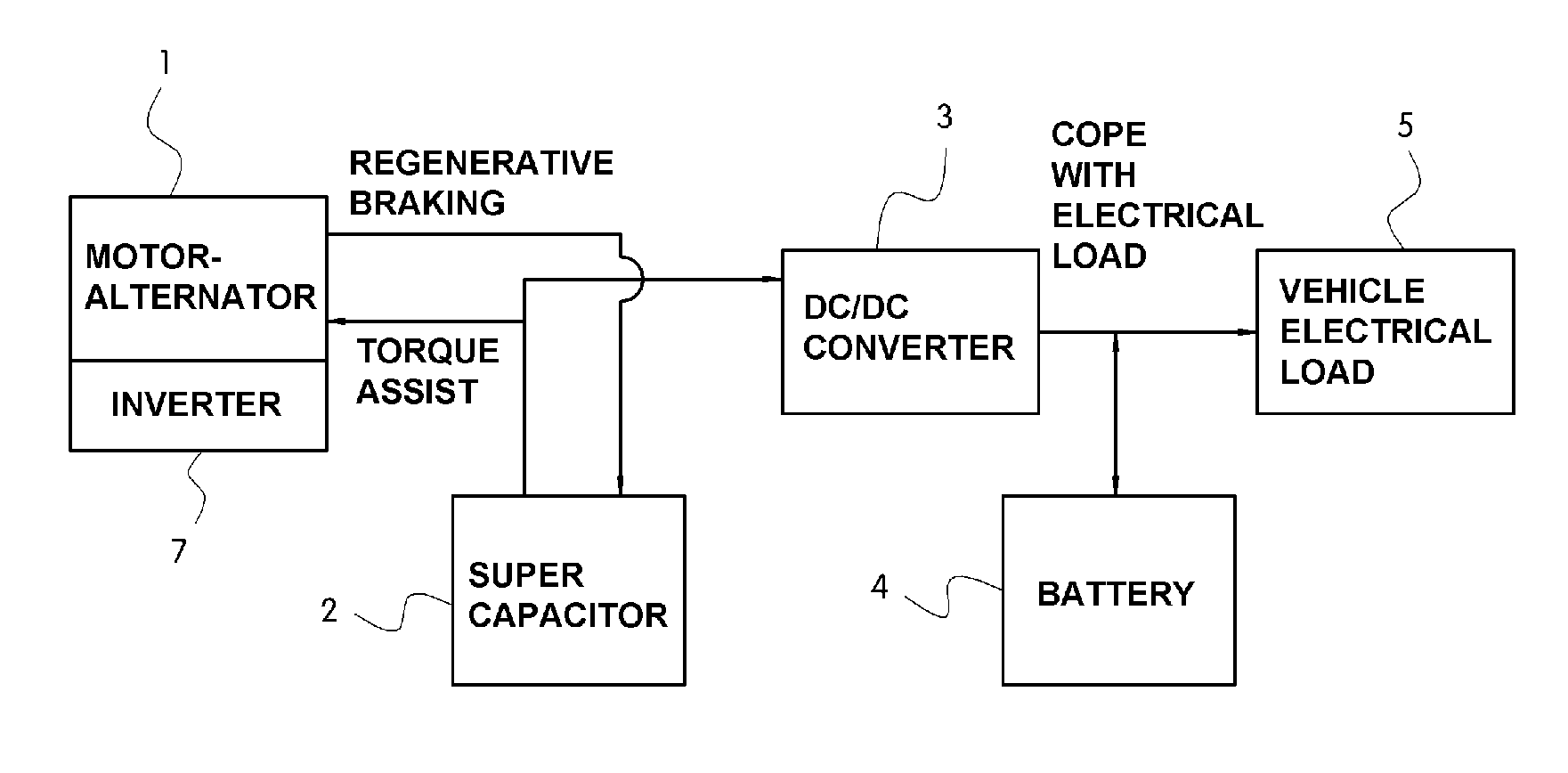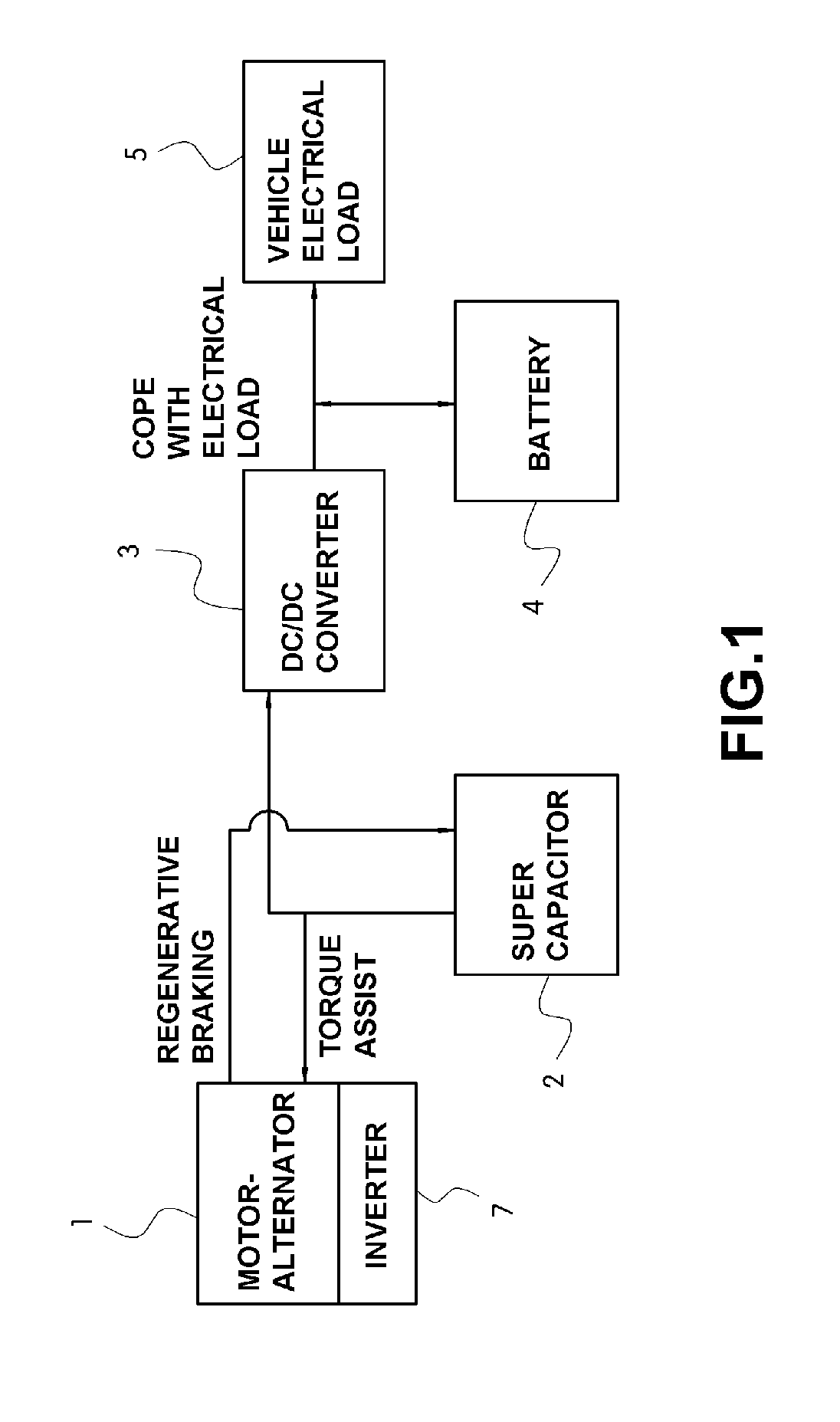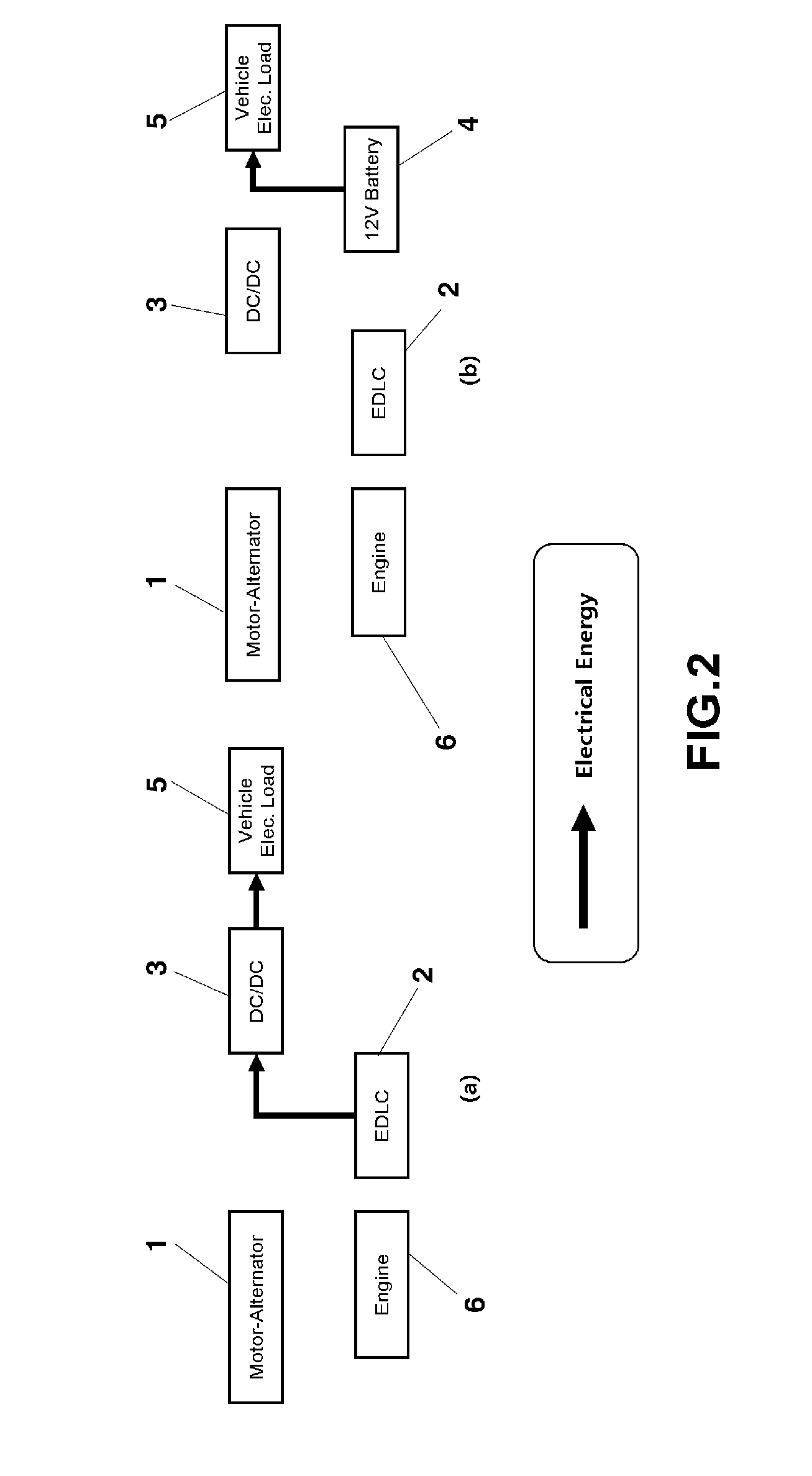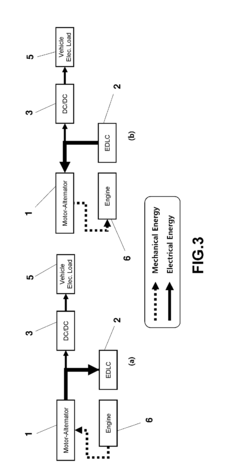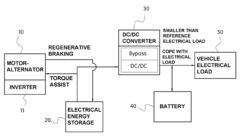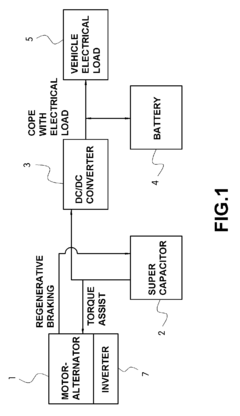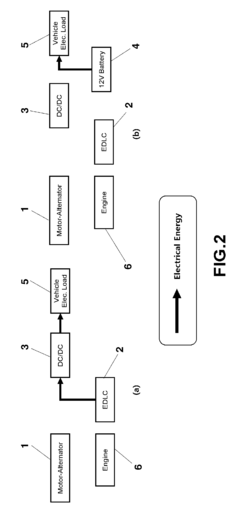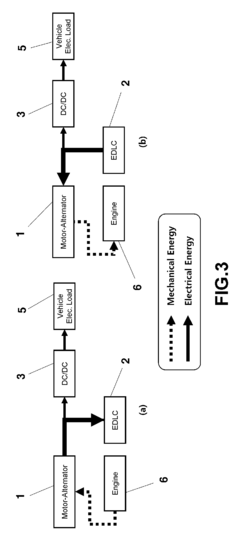Mild hybrid system interaction with vehicle-to-grid technology
AUG 18, 20259 MIN READ
Generate Your Research Report Instantly with AI Agent
Patsnap Eureka helps you evaluate technical feasibility & market potential.
Mild Hybrid V2G Integration: Background and Objectives
Mild hybrid systems and vehicle-to-grid (V2G) technology represent two significant advancements in the automotive industry, each addressing different aspects of energy efficiency and grid integration. The convergence of these technologies presents a unique opportunity to enhance both vehicle performance and grid stability.
Mild hybrid systems have evolved as a cost-effective solution to improve fuel efficiency and reduce emissions in conventional internal combustion engine vehicles. These systems typically employ a small electric motor and battery to assist the engine during acceleration and enable start-stop functionality. The technology has gained traction due to its ability to offer many of the benefits of full hybridization without the complexity and cost associated with high-voltage battery systems.
Vehicle-to-grid technology, on the other hand, has emerged as a promising approach to leverage the growing number of electric vehicles as distributed energy resources. V2G enables bidirectional power flow between vehicles and the electrical grid, allowing vehicles to not only consume electricity but also feed it back to the grid when needed. This capability has the potential to provide grid services such as load balancing, frequency regulation, and peak shaving.
The integration of mild hybrid systems with V2G technology aims to bridge the gap between conventional vehicles and fully electric vehicles in terms of grid interaction capabilities. This convergence presents several objectives and potential benefits for both vehicle manufacturers and grid operators.
One primary objective is to expand the pool of vehicles capable of participating in V2G services. By enabling mild hybrid vehicles to interact with the grid, a larger portion of the vehicle fleet can contribute to grid stability and energy management. This increased participation could accelerate the adoption of V2G technology and its associated benefits.
Another goal is to enhance the energy efficiency and sustainability of mild hybrid vehicles. By incorporating V2G capabilities, these vehicles can potentially utilize excess grid energy during off-peak hours for charging their small batteries, further reducing fuel consumption and emissions. Additionally, the ability to feed energy back to the grid during peak demand periods could provide economic incentives for vehicle owners and contribute to overall grid resilience.
The integration also aims to pave the way for more advanced energy management strategies in vehicles. By combining the real-time engine management capabilities of mild hybrid systems with grid interaction features, vehicles could optimize their energy usage based on both internal factors (e.g., driving conditions) and external factors (e.g., grid demand and electricity prices).
As the automotive industry continues to evolve towards electrification, the integration of mild hybrid systems with V2G technology represents a transitional step that could accelerate the adoption of grid-interactive vehicles. This convergence has the potential to create a more flexible and responsive transportation ecosystem that actively contributes to the stability and efficiency of the electrical grid.
Mild hybrid systems have evolved as a cost-effective solution to improve fuel efficiency and reduce emissions in conventional internal combustion engine vehicles. These systems typically employ a small electric motor and battery to assist the engine during acceleration and enable start-stop functionality. The technology has gained traction due to its ability to offer many of the benefits of full hybridization without the complexity and cost associated with high-voltage battery systems.
Vehicle-to-grid technology, on the other hand, has emerged as a promising approach to leverage the growing number of electric vehicles as distributed energy resources. V2G enables bidirectional power flow between vehicles and the electrical grid, allowing vehicles to not only consume electricity but also feed it back to the grid when needed. This capability has the potential to provide grid services such as load balancing, frequency regulation, and peak shaving.
The integration of mild hybrid systems with V2G technology aims to bridge the gap between conventional vehicles and fully electric vehicles in terms of grid interaction capabilities. This convergence presents several objectives and potential benefits for both vehicle manufacturers and grid operators.
One primary objective is to expand the pool of vehicles capable of participating in V2G services. By enabling mild hybrid vehicles to interact with the grid, a larger portion of the vehicle fleet can contribute to grid stability and energy management. This increased participation could accelerate the adoption of V2G technology and its associated benefits.
Another goal is to enhance the energy efficiency and sustainability of mild hybrid vehicles. By incorporating V2G capabilities, these vehicles can potentially utilize excess grid energy during off-peak hours for charging their small batteries, further reducing fuel consumption and emissions. Additionally, the ability to feed energy back to the grid during peak demand periods could provide economic incentives for vehicle owners and contribute to overall grid resilience.
The integration also aims to pave the way for more advanced energy management strategies in vehicles. By combining the real-time engine management capabilities of mild hybrid systems with grid interaction features, vehicles could optimize their energy usage based on both internal factors (e.g., driving conditions) and external factors (e.g., grid demand and electricity prices).
As the automotive industry continues to evolve towards electrification, the integration of mild hybrid systems with V2G technology represents a transitional step that could accelerate the adoption of grid-interactive vehicles. This convergence has the potential to create a more flexible and responsive transportation ecosystem that actively contributes to the stability and efficiency of the electrical grid.
Market Analysis for V2G-Enabled Mild Hybrid Vehicles
The market for V2G-enabled mild hybrid vehicles is experiencing significant growth potential as the automotive industry shifts towards more sustainable and efficient transportation solutions. This emerging market segment combines the benefits of mild hybrid technology with the capabilities of vehicle-to-grid (V2G) systems, offering a unique value proposition to consumers and utilities alike.
Mild hybrid systems, which provide electric assistance to conventional internal combustion engines, have gained traction due to their cost-effectiveness and improved fuel efficiency. When integrated with V2G technology, these vehicles can not only reduce emissions and fuel consumption but also participate in grid stabilization and energy management services.
The demand for V2G-enabled mild hybrid vehicles is driven by several factors. Firstly, increasing environmental regulations and consumer awareness are pushing automakers to develop more fuel-efficient and eco-friendly vehicles. Mild hybrid systems offer a cost-effective solution to meet these requirements without the complexity of full hybrid or electric powertrains.
Secondly, the growing interest in smart grid technologies and renewable energy integration has created a need for flexible energy storage solutions. V2G-enabled vehicles can serve as distributed energy resources, providing grid services such as peak shaving, frequency regulation, and voltage support. This capability adds value to the vehicle beyond transportation, potentially offering financial incentives to owners through participation in energy markets.
The market size for V2G-enabled mild hybrid vehicles is expected to grow substantially in the coming years. While specific market projections vary, industry analysts anticipate a compound annual growth rate (CAGR) in the double digits for the next decade. This growth is supported by increasing adoption of mild hybrid technology across various vehicle segments and the expansion of V2G infrastructure.
Geographically, Europe and North America are leading the adoption of V2G-enabled mild hybrid vehicles, driven by supportive policies and advanced grid infrastructure. However, Asia-Pacific regions, particularly China and Japan, are expected to see rapid growth in this market segment due to government initiatives promoting electric mobility and smart grid development.
Key market trends include the integration of advanced power electronics and battery management systems to optimize V2G functionality in mild hybrid vehicles. Additionally, there is a growing focus on developing standardized communication protocols and grid integration solutions to ensure interoperability across different vehicle models and utility systems.
Mild hybrid systems, which provide electric assistance to conventional internal combustion engines, have gained traction due to their cost-effectiveness and improved fuel efficiency. When integrated with V2G technology, these vehicles can not only reduce emissions and fuel consumption but also participate in grid stabilization and energy management services.
The demand for V2G-enabled mild hybrid vehicles is driven by several factors. Firstly, increasing environmental regulations and consumer awareness are pushing automakers to develop more fuel-efficient and eco-friendly vehicles. Mild hybrid systems offer a cost-effective solution to meet these requirements without the complexity of full hybrid or electric powertrains.
Secondly, the growing interest in smart grid technologies and renewable energy integration has created a need for flexible energy storage solutions. V2G-enabled vehicles can serve as distributed energy resources, providing grid services such as peak shaving, frequency regulation, and voltage support. This capability adds value to the vehicle beyond transportation, potentially offering financial incentives to owners through participation in energy markets.
The market size for V2G-enabled mild hybrid vehicles is expected to grow substantially in the coming years. While specific market projections vary, industry analysts anticipate a compound annual growth rate (CAGR) in the double digits for the next decade. This growth is supported by increasing adoption of mild hybrid technology across various vehicle segments and the expansion of V2G infrastructure.
Geographically, Europe and North America are leading the adoption of V2G-enabled mild hybrid vehicles, driven by supportive policies and advanced grid infrastructure. However, Asia-Pacific regions, particularly China and Japan, are expected to see rapid growth in this market segment due to government initiatives promoting electric mobility and smart grid development.
Key market trends include the integration of advanced power electronics and battery management systems to optimize V2G functionality in mild hybrid vehicles. Additionally, there is a growing focus on developing standardized communication protocols and grid integration solutions to ensure interoperability across different vehicle models and utility systems.
Technical Challenges in Mild Hybrid V2G Systems
The integration of mild hybrid systems with vehicle-to-grid (V2G) technology presents several technical challenges that need to be addressed for successful implementation. One of the primary obstacles is the limited energy storage capacity of mild hybrid systems compared to full hybrid or electric vehicles. This constraint affects the system's ability to provide substantial power back to the grid, potentially limiting its effectiveness in V2G applications.
Another significant challenge lies in the complexity of power management systems required to balance the needs of the vehicle's propulsion system with the demands of grid interaction. The mild hybrid's smaller battery and motor-generator unit must be carefully managed to ensure optimal performance for both driving and grid support functions. This necessitates sophisticated control algorithms and hardware capable of rapid switching between modes of operation.
The bidirectional power flow inherent in V2G systems introduces additional complications for mild hybrid architectures. The power electronics and inverters must be designed to handle both charging and discharging processes efficiently, while also maintaining the vehicle's primary function of providing motive power. This dual-purpose requirement often leads to increased component costs and potential reliability issues.
Thermal management presents another hurdle in mild hybrid V2G systems. The frequent charging and discharging cycles associated with grid interaction can generate significant heat, which must be effectively dissipated to prevent damage to the battery and other electrical components. This challenge is exacerbated by the compact nature of mild hybrid systems, where space for additional cooling systems is limited.
Communication and control systems pose yet another technical challenge. The vehicle must be equipped with robust, secure, and standardized protocols to interact with various grid infrastructures. This includes real-time monitoring of grid conditions, vehicle state-of-charge, and user preferences, all while ensuring data privacy and system security against potential cyber threats.
Lastly, the integration of V2G functionality into mild hybrid systems must contend with the issue of battery degradation. The increased cycling of the battery due to grid interactions can accelerate wear, potentially shortening the lifespan of the energy storage system. Developing battery chemistries and management strategies that can withstand the demands of both vehicular use and grid support is crucial for the long-term viability of mild hybrid V2G systems.
Another significant challenge lies in the complexity of power management systems required to balance the needs of the vehicle's propulsion system with the demands of grid interaction. The mild hybrid's smaller battery and motor-generator unit must be carefully managed to ensure optimal performance for both driving and grid support functions. This necessitates sophisticated control algorithms and hardware capable of rapid switching between modes of operation.
The bidirectional power flow inherent in V2G systems introduces additional complications for mild hybrid architectures. The power electronics and inverters must be designed to handle both charging and discharging processes efficiently, while also maintaining the vehicle's primary function of providing motive power. This dual-purpose requirement often leads to increased component costs and potential reliability issues.
Thermal management presents another hurdle in mild hybrid V2G systems. The frequent charging and discharging cycles associated with grid interaction can generate significant heat, which must be effectively dissipated to prevent damage to the battery and other electrical components. This challenge is exacerbated by the compact nature of mild hybrid systems, where space for additional cooling systems is limited.
Communication and control systems pose yet another technical challenge. The vehicle must be equipped with robust, secure, and standardized protocols to interact with various grid infrastructures. This includes real-time monitoring of grid conditions, vehicle state-of-charge, and user preferences, all while ensuring data privacy and system security against potential cyber threats.
Lastly, the integration of V2G functionality into mild hybrid systems must contend with the issue of battery degradation. The increased cycling of the battery due to grid interactions can accelerate wear, potentially shortening the lifespan of the energy storage system. Developing battery chemistries and management strategies that can withstand the demands of both vehicular use and grid support is crucial for the long-term viability of mild hybrid V2G systems.
Current Mild Hybrid V2G Integration Solutions
01 Electric motor integration in mild hybrid systems
Mild hybrid systems incorporate electric motors to assist the internal combustion engine, improving fuel efficiency and reducing emissions. These systems typically use a belt-driven or crankshaft-mounted motor-generator that can provide additional power during acceleration and recover energy during braking.- Mild hybrid system architecture: Mild hybrid systems integrate an electric motor/generator with a conventional internal combustion engine to improve fuel efficiency and reduce emissions. The system typically includes a small battery pack and can provide functions such as engine start-stop, regenerative braking, and electric assist during acceleration.
- Energy management and control strategies: Advanced control strategies are employed to optimize the operation of mild hybrid systems. These strategies manage power distribution between the electric motor and combustion engine, control battery charging and discharging, and implement intelligent energy recovery during deceleration and braking.
- Integration with transmission systems: Mild hybrid systems can be integrated with various transmission types, including manual, automatic, and continuously variable transmissions (CVT). The integration aims to enhance overall powertrain efficiency and provide seamless transitions between electric and combustion power sources.
- Battery and electrical system design: The design of the battery pack and electrical system is crucial for mild hybrid performance. This includes optimizing battery capacity, voltage levels, and power electronics to support the system's functions while minimizing weight and cost. Advanced battery management systems are employed to ensure efficient and safe operation.
- Thermal management and efficiency improvements: Thermal management systems are implemented to maintain optimal operating temperatures for both the electric components and the internal combustion engine. This includes cooling systems for the battery and power electronics, as well as heat recovery systems to improve overall energy efficiency of the mild hybrid powertrain.
02 Battery management and energy storage
Efficient battery management and energy storage are crucial components of mild hybrid systems. These systems often utilize advanced lithium-ion batteries or supercapacitors to store and deliver electrical energy quickly. Sophisticated control algorithms optimize battery charging and discharging to maximize system efficiency and longevity.Expand Specific Solutions03 Regenerative braking systems
Mild hybrid systems employ regenerative braking to recover kinetic energy during deceleration and braking. This energy is converted to electrical power and stored in the battery, which can then be used to assist the engine during acceleration or power auxiliary systems. This feature significantly contributes to overall fuel efficiency improvements.Expand Specific Solutions04 Start-stop functionality
Many mild hybrid systems incorporate start-stop functionality, which automatically shuts off the engine when the vehicle comes to a stop and quickly restarts it when the accelerator is pressed. This feature reduces fuel consumption and emissions during idle periods, particularly in urban driving conditions.Expand Specific Solutions05 Integration with transmission systems
Advanced mild hybrid systems are often integrated with the vehicle's transmission to optimize power delivery and efficiency. This integration can include electric motor assistance during gear changes, improved torque management, and seamless transitions between electric and combustion power sources.Expand Specific Solutions
Key Players in Mild Hybrid V2G Development
The mild hybrid system interaction with vehicle-to-grid technology is in an early development stage, with a growing market potential as the automotive industry shifts towards electrification and smart grid integration. The market size is expanding, driven by increasing demand for energy-efficient vehicles and grid stability solutions. Technologically, it's still evolving, with varying levels of maturity among key players. Companies like Hyundai Motor Co., Volkswagen AG, and Ford Global Technologies are at the forefront, investing heavily in R&D. Other significant contributors include Robert Bosch GmbH and ZF Friedrichshafen AG, focusing on component development. The competitive landscape is dynamic, with both established automakers and emerging tech companies vying for market share and technological leadership.
Hyundai Motor Co., Ltd.
Technical Solution: Hyundai has developed an advanced mild hybrid system that seamlessly integrates with vehicle-to-grid (V2G) technology. Their system utilizes a 48V architecture, which allows for improved energy recuperation and electric boost during acceleration[1]. The mild hybrid system incorporates a belt-driven starter generator (BSG) that can quickly switch between motor and generator modes, enabling efficient energy capture during deceleration and providing additional power when needed[2]. Hyundai's V2G integration allows the vehicle to not only draw power from the grid but also feed excess energy back, creating a bidirectional power flow. This system is designed to optimize the vehicle's energy management while also supporting grid stability during peak demand periods[3].
Strengths: Efficient energy recuperation, seamless integration with existing powertrains, and grid support capabilities. Weaknesses: Limited electric-only range compared to full hybrids, and potential increased complexity in vehicle electronics.
Volkswagen AG
Technical Solution: Volkswagen's approach to mild hybrid systems with V2G integration focuses on their MQB (Modular Transverse Matrix) platform. Their system employs a 48V lithium-ion battery coupled with an integrated starter-generator, which replaces the traditional alternator and starter motor[4]. This setup allows for extended start-stop functionality, coasting with the engine off, and electric torque assist. Volkswagen's V2G technology enables their mild hybrid vehicles to participate in grid balancing services, potentially earning revenue for owners during periods of peak electricity demand[5]. The system is designed to be scalable across various vehicle models, from compact cars to SUVs, ensuring widespread adoption of the technology throughout their product lineup[6].
Strengths: Scalable technology across multiple vehicle segments, potential for revenue generation through grid services. Weaknesses: Dependency on widespread V2G infrastructure development, potential battery degradation from frequent grid interactions.
Core Innovations in Mild Hybrid V2G Interaction
Mild hybrid system and method for controlling the same
PatentActiveUS20110115288A1
Innovation
- A mild hybrid system utilizing a unidirectional DC/DC buck converter with a bypass function allows for bidirectional electricity flow, reducing the generation load of the motor-alternator and eliminating the need for a bidirectional converter by directly connecting high and low voltage terminals during high electrical loads, ensuring stable engine start-up.
Mild hybrid system and method for controlling the same
PatentActiveUS9428063B2
Innovation
- A mild hybrid system utilizing a unidirectional DC/DC buck converter with a bypass function to manage electrical energy flow, allowing for bidirectional electricity flow in bypass states and eliminating the need for a bidirectional converter.
Regulatory Framework for V2G Implementation
The regulatory framework for Vehicle-to-Grid (V2G) implementation is a critical aspect of integrating mild hybrid systems with V2G technology. As this technology continues to evolve, governments and regulatory bodies worldwide are developing policies and standards to ensure its safe and efficient deployment.
One of the primary concerns in V2G regulation is grid stability and reliability. Regulatory bodies are establishing guidelines for power quality, voltage control, and frequency regulation to maintain grid stability as vehicles interact with the electrical infrastructure. These regulations often include requirements for inverter technologies and communication protocols to ensure seamless integration between vehicles and the grid.
Safety standards form another crucial component of the V2G regulatory framework. Regulations typically address electrical safety, cybersecurity, and data privacy concerns. For instance, standards are being developed for charging equipment, vehicle-to-grid interfaces, and communication systems to prevent potential hazards and protect user information.
Energy market regulations are also being adapted to accommodate V2G technology. This includes creating new market mechanisms for vehicle owners to participate in energy trading and grid services. Regulatory bodies are working on frameworks for fair compensation, pricing structures, and contractual agreements between vehicle owners, utilities, and grid operators.
Environmental regulations play a significant role in promoting V2G adoption. Many countries are incorporating V2G capabilities into their renewable energy and carbon reduction strategies. Regulations may include incentives for V2G-enabled vehicles or requirements for new buildings to include V2G-ready charging infrastructure.
Interoperability standards are being developed to ensure compatibility between different vehicle models, charging stations, and grid systems. These standards aim to create a unified ecosystem that allows for seamless V2G operations across various manufacturers and regions.
Consumer protection regulations are also emerging to safeguard the interests of vehicle owners participating in V2G programs. These regulations address issues such as battery degradation, warranty considerations, and fair billing practices for energy exchanges.
As the technology matures, regulatory frameworks are likely to evolve, addressing new challenges and opportunities in the V2G landscape. Ongoing collaboration between policymakers, industry stakeholders, and technical experts will be crucial in shaping effective and adaptive regulations for V2G implementation.
One of the primary concerns in V2G regulation is grid stability and reliability. Regulatory bodies are establishing guidelines for power quality, voltage control, and frequency regulation to maintain grid stability as vehicles interact with the electrical infrastructure. These regulations often include requirements for inverter technologies and communication protocols to ensure seamless integration between vehicles and the grid.
Safety standards form another crucial component of the V2G regulatory framework. Regulations typically address electrical safety, cybersecurity, and data privacy concerns. For instance, standards are being developed for charging equipment, vehicle-to-grid interfaces, and communication systems to prevent potential hazards and protect user information.
Energy market regulations are also being adapted to accommodate V2G technology. This includes creating new market mechanisms for vehicle owners to participate in energy trading and grid services. Regulatory bodies are working on frameworks for fair compensation, pricing structures, and contractual agreements between vehicle owners, utilities, and grid operators.
Environmental regulations play a significant role in promoting V2G adoption. Many countries are incorporating V2G capabilities into their renewable energy and carbon reduction strategies. Regulations may include incentives for V2G-enabled vehicles or requirements for new buildings to include V2G-ready charging infrastructure.
Interoperability standards are being developed to ensure compatibility between different vehicle models, charging stations, and grid systems. These standards aim to create a unified ecosystem that allows for seamless V2G operations across various manufacturers and regions.
Consumer protection regulations are also emerging to safeguard the interests of vehicle owners participating in V2G programs. These regulations address issues such as battery degradation, warranty considerations, and fair billing practices for energy exchanges.
As the technology matures, regulatory frameworks are likely to evolve, addressing new challenges and opportunities in the V2G landscape. Ongoing collaboration between policymakers, industry stakeholders, and technical experts will be crucial in shaping effective and adaptive regulations for V2G implementation.
Environmental Impact of Mild Hybrid V2G Systems
The integration of mild hybrid systems with vehicle-to-grid (V2G) technology presents a significant opportunity for reducing the environmental impact of transportation. This combination leverages the benefits of both technologies to create a more sustainable and efficient energy ecosystem. Mild hybrid systems, which incorporate a small electric motor to assist the internal combustion engine, already contribute to reduced fuel consumption and lower emissions. When coupled with V2G capabilities, these systems can further enhance their environmental benefits.
One of the primary environmental advantages of mild hybrid V2G systems is their potential to optimize grid energy usage. By allowing vehicles to feed electricity back into the grid during peak demand periods, these systems can help balance the load on power networks. This load balancing effect can reduce the need for additional power plants, particularly those relying on fossil fuels, which are often used to meet peak demand. Consequently, this leads to a decrease in overall carbon emissions from electricity generation.
Moreover, the bidirectional energy flow enabled by V2G technology can support the integration of renewable energy sources into the grid. Mild hybrid vehicles equipped with V2G capabilities can act as distributed energy storage units, absorbing excess renewable energy during periods of high production and low demand. This stored energy can then be fed back into the grid when renewable sources are not generating sufficient power, effectively smoothing out the intermittency issues associated with solar and wind energy.
The environmental impact of mild hybrid V2G systems extends to urban air quality improvement. By promoting the use of electric power for short trips and in congested areas, these systems can significantly reduce local emissions of particulate matter, nitrogen oxides, and other pollutants associated with internal combustion engines. This is particularly beneficial in densely populated urban areas where air quality is a major concern.
Additionally, the implementation of mild hybrid V2G systems can contribute to the reduction of overall vehicle lifecycle emissions. By extending the useful life of vehicle batteries through grid services and optimizing their charging cycles, the environmental costs associated with battery production and disposal can be mitigated. Furthermore, the improved efficiency of mild hybrid powertrains, combined with smart grid integration, can lead to a decrease in the total energy consumption of the transportation sector.
However, it is important to consider the potential environmental trade-offs. The increased complexity of mild hybrid V2G systems may result in higher manufacturing emissions and resource consumption. Therefore, a comprehensive lifecycle assessment is crucial to fully understand and quantify the net environmental benefits of these systems.
One of the primary environmental advantages of mild hybrid V2G systems is their potential to optimize grid energy usage. By allowing vehicles to feed electricity back into the grid during peak demand periods, these systems can help balance the load on power networks. This load balancing effect can reduce the need for additional power plants, particularly those relying on fossil fuels, which are often used to meet peak demand. Consequently, this leads to a decrease in overall carbon emissions from electricity generation.
Moreover, the bidirectional energy flow enabled by V2G technology can support the integration of renewable energy sources into the grid. Mild hybrid vehicles equipped with V2G capabilities can act as distributed energy storage units, absorbing excess renewable energy during periods of high production and low demand. This stored energy can then be fed back into the grid when renewable sources are not generating sufficient power, effectively smoothing out the intermittency issues associated with solar and wind energy.
The environmental impact of mild hybrid V2G systems extends to urban air quality improvement. By promoting the use of electric power for short trips and in congested areas, these systems can significantly reduce local emissions of particulate matter, nitrogen oxides, and other pollutants associated with internal combustion engines. This is particularly beneficial in densely populated urban areas where air quality is a major concern.
Additionally, the implementation of mild hybrid V2G systems can contribute to the reduction of overall vehicle lifecycle emissions. By extending the useful life of vehicle batteries through grid services and optimizing their charging cycles, the environmental costs associated with battery production and disposal can be mitigated. Furthermore, the improved efficiency of mild hybrid powertrains, combined with smart grid integration, can lead to a decrease in the total energy consumption of the transportation sector.
However, it is important to consider the potential environmental trade-offs. The increased complexity of mild hybrid V2G systems may result in higher manufacturing emissions and resource consumption. Therefore, a comprehensive lifecycle assessment is crucial to fully understand and quantify the net environmental benefits of these systems.
Unlock deeper insights with Patsnap Eureka Quick Research — get a full tech report to explore trends and direct your research. Try now!
Generate Your Research Report Instantly with AI Agent
Supercharge your innovation with Patsnap Eureka AI Agent Platform!
